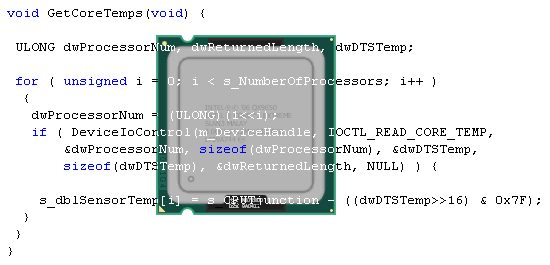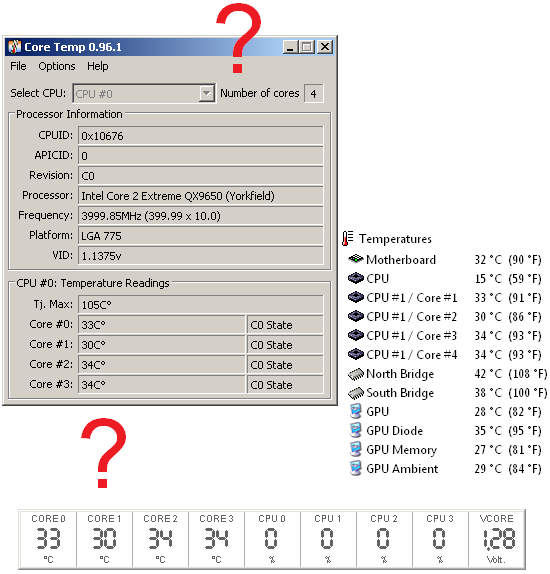Intel's 45nm Dual-Core E8500: The Best Just Got Better
by Kris Boughton on March 5, 2008 3:00 AM EST- Posted in
- CPUs
"Accurate" Temperature Monitoring?
In the past, internal CPU temperatures were sensed using a single on-die diode connected to an external measurement circuit, which allowed for an easy means of monitoring and reporting "actual" processor temperatures in near real-time. Many motherboard manufacturers took advantage of this capability by interfacing the appropriate processor pins/pads to an onboard controller, such as one of any of the popular Super I/O chips available from Winbond. Super I/O chips typically control most if not all of the standard motherboard input/output traffic associated with common interfaces including floppy drives, PS/2 mice and keyboards, high-speed programmable serial communications ports (UARTs), and SPP/EPP/ECP-enabled parallel ports. Using either a legacy ISA bus interface or a newer LPC (low pin-count) interface, the Super I/O also monitors several critical PC hardware parameters like power supply voltages, temperatures, and fan speeds.
This method of monitoring CPU temperature functioned satisfactorily up until Intel conducted their first process shrink to 65nm. The reduction in circuit size influenced some of the temperature-sensing diode's operating characteristics enough that no amount of corrective calibration effort would be able to ensure sufficient accuracy over the entire reporting range. From this point on Intel engineers knew they would need something better. From this came the design we see effectively utilized in every CPU produced by Intel today, starting with Yonah - one of the first 65nm processors and a precursor to the now wildly-successful Core 2 architecture.
The new design, called a Digital Thermal Sensor (DTS), no longer relied on the use of an external biasing circuit where power conditioning tolerances and slight variances in sense line impedances can introduce rather large signaling errors. Because of this, many of the reporting discrepancies noted using the older monitoring methods were all but eliminated. Instead of relying on each motherboard manufacturer to design and implement this external interface, Intel made it possible for core temperatures to be retrieved easily, all without the need for any specialized hardware. This was accomplished through the development and documentation of a standard method for reading these values directly from a single model specific registers (MSR) and then computing actual temperatures by applying a simple transformation formula. This way the complicated process of measuring these values would be well hidden from the vendor.

A few quick lines of code (excluding the custom device driver required) is all that is needed to quickly retrieve and report values encoded in an MSR for each core.
The transformation formula we spoke of is actually exceedingly simple to implement. Instead of storing the absolute temperature for each core, the MSR is designed to essentially count down the margin to the core's maximum thermal limit, often incorrectly referred to as "Tjunction" (or junction temperature). When this value reaches zero, the core temperature has reached its Tjunction set point. Therefore, calculating the actual temperature should be as easy as subtracting the remaining margin (stored in the MSR) from the processor's known Tjunction value. There is a problem however: Intel has never published Tjunction values for any CPU other than the mobile models. The reason for this is simple. Since mobile processors lack an integrated heat spreader (IHS), it is not possible to establish a thermal specification with respect to its maximum case temperature ("Tcase"), normally measured from an embedded probe located top, dead-center in the IHS.
Thus, calculating actual core temperatures requires two separate data points, only one of which is readily available from the MSR. The other, Tjunction, must be known ahead of time. Early implementations of the process used to determine a processor's particular Tjunction value by isolating a single status bit from a different MSR that was used flag whether the part in question was engineered to a maximum Tjunction set point of either 85ºC or 100ºC. Because Merom - the mobile Core 2 version of Conroe - used one of these two values, it was somehow decided that the desktop products, built on the same process, must also share these set points. Unfortunately, it turns out this is not the case.

All of these prominent means for monitoring Intel CPU core temperatures are based on assumed maximum Tjunction setpoints which cannot be verified.
More than a few programs have been released over the last few years, each claiming to accurately report these DTS values in real-time. The truth is that none can be fully trusted as the Tjunction values utilized in these transformations may not always be correct. Moreover, Intel representatives have informed us that these as-of-yet unpublished Tjunction values may actually vary from model to model - sometimes even between different steppings - and that the temperature response curves may not be entirely accurate across the whole reporting range. Since all of today's monitoring programs have come to incorrectly assume that Tjunction values are a function of the processor family/stepping only, we have no choice but to call everything we thought we had come to know into question. Until Intel decides to publish these values on a per-model basis, the best these DTS readings can do for us is give a relative indication of each core's remaining thermal margin, whatever that may be.










45 Comments
View All Comments
chizow - Wednesday, March 5, 2008 - link
Only had an issue with this statement:While this may be true for those building a new system around a new CPU, this might not hold true for those looking to overclock using an existing board. These 45nm CPUs with their higher stock 1333 FSB will by necessity use lower multipliers which essentially eats into potential FSB overclocks on FSB-limited chipsets. Considering many 6-series NV chipsets and boards will not support Penryn *at all* this is a very real consideration for those looking to upgrade to something faster.
Given my experiences with NV 6-series chipsets compared to reviews, I'm not overly optimistic about Penryn results on the 7-series either. Curious as to which board you tested these 45nm with? I haven't kept up with P35/X38 capabilities but the SS you showed had you dropping the multiplier which is a feature I thought was limited to NV chipsets? I might have missed it in the article, but clarification would be appreciated.
TheJian - Thursday, March 6, 2008 - link
I have a problem with this part of that statement "Intel has also worked hard to make all of this performance affordable." They forget it was AMD who forced Intel to cut margins on cpus from 62% (I think that was their high a few years back) to a meager 48% (if memory serves) and their profits to tank 60% in some quarters while driving AMD into the ground. Do they think they were doing it for our sakes? NOT. It was to kill AMD (and it worked). WE just got LUCKY.How much INTEL butt kissing can you do in one article? Notice that since AMD has sucked Intel is starting to make an ABOUT FACE on pricing. Server chips saw an increase of 20% about a month ago or so (it was written about everywhere). Now we see the E8400 which was $209 on newegg just a few weeks ago and IN STOCK, is said to go for $250 if you believe Anandtech. Even newegg has their future chips when they come back in stock now priced at $239. That's a $30 increase! What is that 14% or so? I missed the first E8400's and thought it would go down, instead Intel restricts volume and causes a price hike to soak us since AMD sucks now. I hope AMD puts out a decent chip shortly (phenom 3ghz would be a good start) so we can stop the price hikes.
What's funny to me is the reviewers let Intel get away with pricing in a review that comes nowhere near what it ACTUALLY debuts for. They've done the same for Nvidia also (not just anand, but others as well). The cards always end up being $50 more than MSRP. Which screws competitors because we all wait for said cheap cpu/gpu and end up not buying a very good alternative at the time (on the basis of false pricing from Intel/Nvidia). They should just start saying in reviews, "but expect $50 more upon debut than they say because they always LIE to get you to not buy the competitors product". That would at least be more accurate. For the record I just bought an 8800GT and will buy a wolfdate in a few weeks :) My problem here is the reviewers not calling them out on this crap. Why is that?
mindless1 - Wednesday, March 5, 2008 - link
Yes you are right that the higher default FSB works against them, it would be better if a Pentium or Celeron 45nm started with lower FSB so the chipsets had enough headroom for good overclock.NV is not the only one that can drop the multiplier, I've not tried it on X38 but have on P35 and see no reason why a motherboard manufacturer would drop such a desirable feature unless the board simply was barren of o'c features, something with OEM limited bios perhaps.
Psynaut - Wednesday, March 5, 2008 - link
It took me a minute to figure out that they were talking about the chips that were released 6-8 weeks ago.squito - Wednesday, March 5, 2008 - link
Same here ... maybe they need to be reintroduced?Johnbear007 - Wednesday, March 5, 2008 - link
Where in the U.S. do you see a Q6600 for under 200$???? I still see it at 245$ at newegg and your own anandtechshopping search doesn't come anywhere near the pricepoint you mention.XtAzY - Wednesday, March 5, 2008 - link
If you take a look at Hot Deals last month, you could have gotten a q6700 for $80http://hardforum.com/showpost.php?p=1032017513&...">http://hardforum.com/showpost.php?p=1032017513&...
but of course it's already over
smithkt - Wednesday, March 5, 2008 - link
That was for the e6700 not the q6700firewolfsm - Wednesday, March 5, 2008 - link
With core 2s, you can always do a minor frequency overclock while actually undervolting it. With a decent cooler, it could even last longer than stock.ap90033 - Wednesday, March 5, 2008 - link
Is it me or was this a little to negative on the OC stuff? I mean really, if you have good cooling, keep the voltage 1.44 or lower I bet the CPU would last 2-3 years or more...It almost sounds like they are marketing for Intel, "Great Overclokcer" but wait dont OC just get the highest model or it will only last 10 minutes!